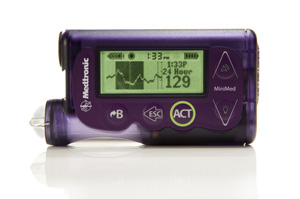
An Australian study has found that smart insulin pumps, which shut off insulin delivery when low glucose readings are detected, can dramatically lower the risk of hypoglycemia, according to a HealthDay report. Researchers report smart pump users had 4 times fewer bouts of moderate to severe hypoglycemia than those using standard pumps over the course of half a year.
The study, led by Dr. Timothy Jones of Princess Margaret Hospital for Children in Perth, Australia, tracked 49 T1 patients on standard pump therapy and 46 patients using a Medtronic smart-pump with “low-glucose suspend” (a technology which uses algorithms to suspend insulin delivery if low blood sugar is detected). Before adopting the smart pump, the 46 patients, presumably on injectable insulin therapy, experienced 6 times more moderate to severe bouts of hypoglycemia than those using standard pump therapy. But a half year into the experiment, the tables were turned, as the 46 who adopted the smart pump experienced 4 times fewer bouts of hypoglycemia than their counterparts on standard pump therapy. Dr. Jones believes the study shows that widespread smart pump adoption could save lives.
The smart pump that was the focus of the study was the Medtronic Veo, a smart pump approved for use in much of Europe and Australia, but not in the U.S. The Veo is very similar in design to the Medtronic MiniMed 530g, which was the first smart pump to gain FDA approval in September 2013. (See Insulin Nation’s “Medtronic’s ‘Artificial Pancreas’ Gains FDA Approval”). The MiniMed 530g comes with smart sensors which can set off an alarm and automatically suspend insulin delivery for two hours if glucose levels are detected that are lower than the limit set by the wearer. The dual advantage of such a technology is that it can eliminate the need for the user to make decisions on insulin doses while dealing with low glucose and it can reduce the spectre of nighttime hypoglycemia.
The Veo is nearly identical to the MiniMed 530g, except that it has the option of a different range of settings for the alarm threshold and it allows a greater amount of bolus (75 units) than the MiniMed (25 units), according to Medtronic spokeswoman Amanda McNulty Sheldon.
Thanks for reading this Insulin Nation article. Want more Type 1 news? Subscribe here.
Have Type 2 diabetes or know someone who does? Try Type 2 Nation, our sister publication.







